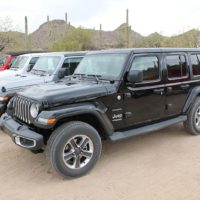
It’s been no secret that over the past few years, we’ve seen the automotive market sway heavily toward utility vehicles (Light Trucks, SUVs, CUVs) and away from the traditional car. This trend has allowed brands such as Jeep to thrive as they have accounted for nearly half of all FCA vehicles sold worldwide in the past three years. Part of the reason for that has been the continued success of one of the most iconic vehicles still available today, the Jeep Wrangler.
Although the previous generation JK model had remained largely unchanged for much of its ten-year run, the sales numbers and overall popularity of the vehicle definitely did not reflect that. In saying that, it was definitely time for some updates, and as you may have seen, Jeep has done just that by rolling out the all-new 2018 Wrangler JL. To mark the occasion and to get some seat time, I was flown out to Tucson, Arizona which proved to be the perfect setting to put Jeep’s latest Wrangler through its paces.
Refined, authentic. This was the slogan being bandied about by Jeep and FCA representatives throughout the event, and for good reason, as they are probably the best two words to describe the changes and upgrades seen on the new JL.

Inside of the Wrangler is perhaps where the biggest change was needed. The previous generation Jeep Wrangler JK debuted in 2007, which is exactly where you felt you were when you got behind even a 2017 model. For starters, gone is the antiquated and hard-to-use infotainment system, in favour of the new Uconnect 3 or 4 systems with three different screen sizes available – 5-, 7-, or 8.4-in. depending on model and trim package. Apple CarPlay and Android Auto have further increased functionality, while an available 7-in. cluster display is able to show you things like off-road angles, tire pressures and audio information. A backup camera is finally standard, and over 75 standard and available safety systems are offered.

The Wrangler JL will debut with two available powertrain options – the returning 3.6-litre Pentastar V6 pushing out 285 horsepower and 260 lb-ft of torque, and the new 2.0-litre turbocharged I4 that produces 270 horsepower and 295 lb-ft of torque. Both engines feature stop/start technology and are paired to a new 8-speed automatic transmission with the V6 also offering a 6-speed manual option. The 3.6 felt very much the same as it was in the JK, which is not necessarily a bad thing. It provides more than adequate power and won’t break the bank at the gas pump. In saying that, I thought the better of the two options was the turbocharged 2.0 as it provided basically the same power numbers but added smoother acceleration and better throttle response, and would undoubtedly provide better fuel economy numbers than its larger and thirstier counterpart.
Although it was as capable as it ever has been off-road, on-road driving is where I felt the JK was seriously lacking. It felt sort of like a box-on-wheels and challenged you to produce a smooth ride even on the nicest, straightest roads. Thankfully, this new version has fully addressed this and offers a much more refined ride than its predecessor. The new JL provides smoother acceleration, handles corners much better, and is less clunky feeling overall. In saying that, the Wrangler will probably never be quite as smooth as some of the car-like SUVs/CUVs, but this is a sacrifice most Jeep fans are willing to make in order to gain the iconic look and legendary capability.

During the media drive in Tucson, we started by taking some Sahara and Sport models through a mostly on-road driving loop that provided some high-speed freeways and low-speed twisty mountain roads. After our very cool first stop at the Old Tucson Movie Studio and Theme Park, we were told to head towards a place called Saguaro Ranch where there was a fleet of Rubicon models and a challenging off-road course. Once we entered the Ranch, we were faced with some pretty harsh terrain just to get to the meeting point where our Rubicons awaited. Not surprisingly, after switching to four-high, our Jeeps handled the journey without incident and eventually got us there in short order.
After a brief (but very good) lunch, we were told that the off-road course was ready and to grab one of the available Rubicons and have at it. To further its off-road prowess, the Rubicon models are fitted with front and rear electronic locking differentials, an electronically disconnecting sway bar, and 33-in. BFGoodrich K02 all-terrain tires. Although very few people would ever put their brand new Jeep through such challenging terrain, Jeep seemed to be determined to show just how truly capable this new model is.
The course had everything from very steep rocky hill climbs, to three point turns at the apex of said hill, to just-as-tough descents back to the flat ground. There were points when only three wheels were on the ground and others where you were sure you were convinced you were about to roll the Wrangler right on to its roof. The course certainly confronted the Jeep’s capabilities at times, but the experience left us with no doubt that this vehicle was made to be put through them and come out unscathed on the other side.
I could go on and on with even more details about the Jeep Wrangler JL, such as the very cool information plate bolted on to the tailgate that displays the vehicle’s exterior dimensions and water fording capabilities (30-in. or 76.2cm at 8 km/h), but I think it would be shorter just to say that I was impressed by virtually everything on this vehicle. It is in every way better than the previous model but has retained enough of its heritage to keep even the most ardent purists happy. It couldn’t have been an easy job to redesign an icon, but the results speak for themselves. Refined, authentic.



























































